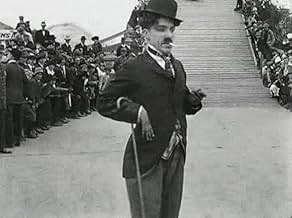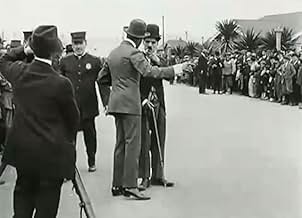CALIFICACIÓN DE IMDb
5.7/10
3.5 k
TU CALIFICACIÓN
Agrega una trama en tu idiomaThe Tramp wanders into and disrupts the filming of a go-kart race.The Tramp wanders into and disrupts the filming of a go-kart race.The Tramp wanders into and disrupts the filming of a go-kart race.
- Dirección
- Guionistas
- Elenco
- Premios
- 1 premio ganado en total
- Dirección
- Guionistas
- Todo el elenco y el equipo
- Producción, taquilla y más en IMDbPro
Opiniones destacadas
The Keystone period of Chaplin's work (1914) always suffers in comparison to his later films, especially the Mutuals and First Nationals. This is because he was still learning his craft, but mostly because Mack Sennett kept making the same film over and over again. While the majority of Keystones are indistinguishable from one another, this short subject, only Charlie's second, towers above the others. Here Chaplin attends an actual event in Venice (California) as a spectator pretending to be unaware that he is constantly getting in the cameraman's frame. Time has been positively affectionate to this film; appearing on camera is now a national pastime, and being a split reel it clocks in at about the same length as a Saturday Night Live skit. This film deserves your attention. It won't take long.
Tramp's first appearance and... he's a punk. Fun and meta at first, at least in the way that it's a movie about movie-making at a time when that was a fresh idea, but wears out its welcome as it's a one-note gag. There's not really any of Chaplin's great comically timed physical gags, it's just him being an a-hole getting in the way of a camera crew as they try to get footage of cars racing by. I wish there was more to it as Chaplin clearly already owns the role, but there's none of the charm or innocence yet. Guess these things would take time to alter, though unlike, say, Mickey Mouse's early appearances (comparing to iconic comic figures of the early 20th century), being an ass doesn't suit the Tramp so well, at least not to this extent (if maybe he'd just interacted with another character or built upon something that'd be one thing).
... who don't even know that they are the cast. You could do this sort of thing back before there were too many lawyers and too many laws. This is the first time that Chaplin dons the "Little Tramp" persona with his bowler, cane, tight coat, and baggy pants, although it was his second film.
He merely gets in the way of the crowd and the cameramen trying to film said Kid Auto Races at Venice, actually the Junior Vanderbilt Cup race. There is no evidence this race was held prior to or after 1914. Some carts had engines, some did not.
The point is, all of these spectators and relatives are very interested in the outcome of the race, as are the cameramen trying to photograph the event. And this obnoxious fellow keeps stumbling into the street, blocking their view, getting into the line of sight of the cameras, and spectators and cameramen keep pushing him out only to have him stumble back into the street and in the way.
Eventually some of the spectators are actually watching this clown and laughing at him rather than being annoyed. That was the magic of Chaplin even from the beginning. Notice that there are some cops around and that they have no guns, even in a semi-urban setting like this. Also note that they don't interfere with Chaplin. Did the director let the cops in on the joke, maybe give them a few bucks to let them make their movie and then leave? Maybe.
When you watch this, understand that until just a short time before, movies were just "actualities" - the filming of ordinary events such as people going to and from work and the tearing down of a building. Just the year before Chaplin had been a performer in music halls. His relationship to motion pictures was brand new.
This was shot in February 1914, six months before WWI begins and three years before America enters that war. Not quite two years after the sinking of the Titanic, just to give some perspective.
He merely gets in the way of the crowd and the cameramen trying to film said Kid Auto Races at Venice, actually the Junior Vanderbilt Cup race. There is no evidence this race was held prior to or after 1914. Some carts had engines, some did not.
The point is, all of these spectators and relatives are very interested in the outcome of the race, as are the cameramen trying to photograph the event. And this obnoxious fellow keeps stumbling into the street, blocking their view, getting into the line of sight of the cameras, and spectators and cameramen keep pushing him out only to have him stumble back into the street and in the way.
Eventually some of the spectators are actually watching this clown and laughing at him rather than being annoyed. That was the magic of Chaplin even from the beginning. Notice that there are some cops around and that they have no guns, even in a semi-urban setting like this. Also note that they don't interfere with Chaplin. Did the director let the cops in on the joke, maybe give them a few bucks to let them make their movie and then leave? Maybe.
When you watch this, understand that until just a short time before, movies were just "actualities" - the filming of ordinary events such as people going to and from work and the tearing down of a building. Just the year before Chaplin had been a performer in music halls. His relationship to motion pictures was brand new.
This was shot in February 1914, six months before WWI begins and three years before America enters that war. Not quite two years after the sinking of the Titanic, just to give some perspective.
6tavm
Kid Auto Races in Venice is historical in that it marks Charlie Chaplin's first appearance as The Tramp. In this short film, The Tramp is a spectator in a soap box derby race that is being filmed. Throughout the short, Charlie keeps getting in front of the camera and getting pushed off by either the cameraman or other spectators. In addition, he almost gets knocked off by some of the kid racers! Obviously not much to mention of the plot of this six minute short but for some reason I was constantly amused by Chaplin's constant wandering in and out of the path of where the race cars were going as well as the cameraman's attempts to get him out of the way. Worth a look for film history buffs and the easily amused.
"Kids Auto Races At Venice" (1914, Lehrman) This film marks the second film Charlie acted in and the first time we would see the famous 'tramp' character. It's six minutes of Charlie at a racing cart/box/derby race thing walking onto the racing track and in front of the cameraman. He is constantly shoved or knocked out of the picture. It's neat that the film gives us the 'camera' eye as well as a couple of other points of view. So we get to see Charlie intentionally blocking the camera and getting manhandled for it repeatedly. Charlie is like a fly that won't shoo. But, alas, six minutes of one routine is a bit much. And yet, this film is as much a part of our film history as any other 'important' picture. It's 1914 dudes!!
¿Sabías que…?
- TriviaThis was the first film in which Charles Chaplin played his most famous character, The Tramp. With only a small number of exceptions, Chaplin would play only The Tramp (or slight variations on the character) on film until El gran dictador (1940).
- ConexionesEdited into Risas y más risas (1960)
Selecciones populares
Inicia sesión para calificar y agrega a la lista de videos para obtener recomendaciones personalizadas
Detalles
- Fecha de lanzamiento
- País de origen
- Sitios oficiales
- Idiomas
- También se conoce como
- Kid Auto Races in Venice, Calif.
- Locaciones de filmación
- 1300 Main Street, Los Ángeles, California, Estados Unidos(intersection where filming took place)
- Productora
- Ver más créditos de la compañía en IMDbPro
- Tiempo de ejecución
- 11min
- Color
- Mezcla de sonido
- Relación de aspecto
- 1.33 : 1
Contribuir a esta página
Sugiere una edición o agrega el contenido que falta






















